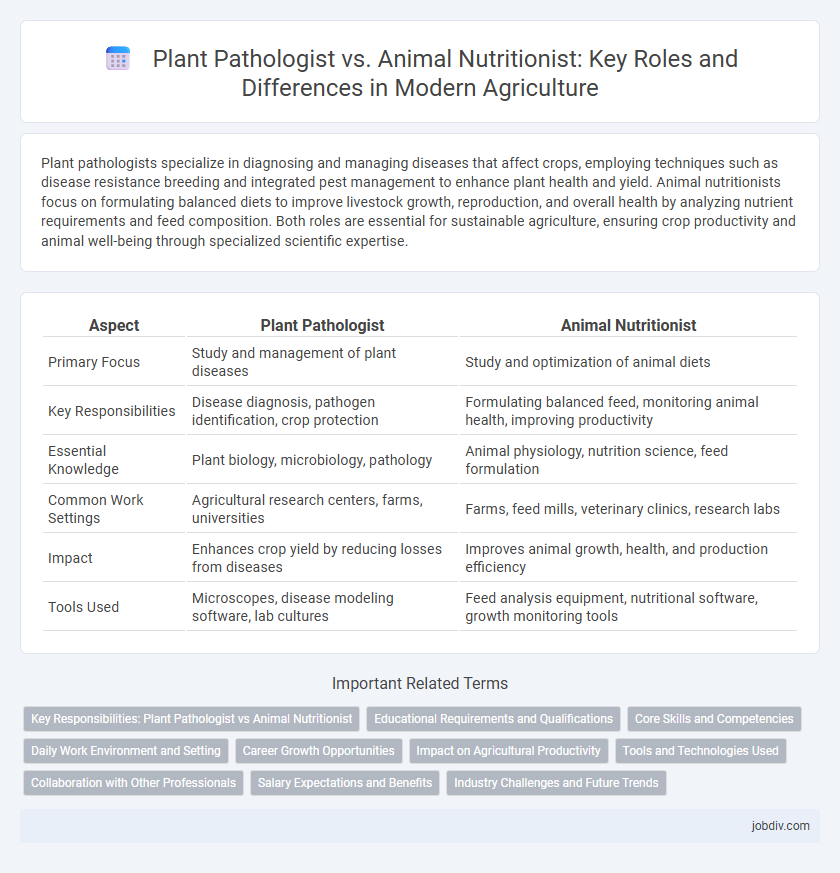Plant pathologists specialize in diagnosing and managing diseases that affect crops, employing techniques such as disease resistance breeding and integrated pest management to enhance plant health and yield. Animal nutritionists focus on formulating balanced diets to improve livestock growth, reproduction, and overall health by analyzing nutrient requirements and feed composition. Both roles are essential for sustainable agriculture, ensuring crop productivity and animal well-being through specialized scientific expertise.
Table of Comparison
| Aspect | Plant Pathologist | Animal Nutritionist |
|---|---|---|
| Primary Focus | Study and management of plant diseases | Study and optimization of animal diets |
| Key Responsibilities | Disease diagnosis, pathogen identification, crop protection | Formulating balanced feed, monitoring animal health, improving productivity |
| Essential Knowledge | Plant biology, microbiology, pathology | Animal physiology, nutrition science, feed formulation |
| Common Work Settings | Agricultural research centers, farms, universities | Farms, feed mills, veterinary clinics, research labs |
| Impact | Enhances crop yield by reducing losses from diseases | Improves animal growth, health, and production efficiency |
| Tools Used | Microscopes, disease modeling software, lab cultures | Feed analysis equipment, nutritional software, growth monitoring tools |
Key Responsibilities: Plant Pathologist vs Animal Nutritionist
Plant pathologists focus on diagnosing and managing plant diseases by studying pathogens and environmental factors that affect crop health, aiming to improve agricultural productivity. Animal nutritionists analyze and formulate balanced diets to optimize livestock growth, health, and production efficiency by evaluating nutrient requirements and feed composition. Both professionals play critical roles in sustainable agriculture, with plant pathologists safeguarding crop yield and animal nutritionists enhancing animal performance.
Educational Requirements and Qualifications
Plant pathologists typically require a bachelor's degree in plant science, biology, or agriculture, with many positions demanding a master's or doctorate specializing in plant disease management and pathology. Animal nutritionists generally hold degrees in animal science, nutrition, or agricultural science, with advanced studies emphasizing animal diet formulation, feed science, and metabolic processes. Both careers require strong foundations in biology and chemistry, but plant pathology focuses on pathogen identification and plant health, while animal nutrition centers on optimizing diet for livestock productivity and health.
Core Skills and Competencies
Plant Pathologists excel in diagnosing plant diseases, understanding pathogen interactions, and developing effective disease management strategies, with strong skills in microbiology, molecular biology, and field research. Animal Nutritionists specialize in formulating optimal diets, analyzing feed components, and improving animal health and productivity through knowledge of biochemistry, physiology, and nutritional science. Both professions require critical thinking, data analysis, and communication skills, but they apply these competencies to distinct biological systems in agriculture.
Daily Work Environment and Setting
Plant pathologists primarily work in laboratories, greenhouses, and agricultural fields, conducting research to identify and control plant diseases affecting crops. Animal nutritionists operate in farms, research centers, and feed manufacturing facilities, focusing on formulating diets that improve livestock health and productivity. Both professionals collaborate with farmers and agricultural specialists but engage with distinctly different environments tailored to plant health and animal dietary needs.
Career Growth Opportunities
Plant pathologists experience growing demand as global food security challenges intensify, with career opportunities expanding in agricultural research, crop protection, and biotechnology sectors. Animal nutritionists see increasing growth driven by advancements in livestock feed efficiency, sustainable farming practices, and regulatory requirements for animal health and production. Both professions benefit from interdisciplinary collaboration, but plant pathologists often engage more with genetic engineering technologies, whereas animal nutritionists focus on dietary optimization and animal welfare trends.
Impact on Agricultural Productivity
Plant pathologists enhance agricultural productivity by diagnosing and managing plant diseases, reducing crop losses and improving yield quality. Animal nutritionists optimize livestock diets to boost growth rates, reproduction, and overall health, increasing meat, milk, and egg production. Both specialists contribute critically to sustainable farming by improving the efficiency and resilience of crop and animal production systems.
Tools and Technologies Used
Plant pathologists utilize advanced molecular diagnostics, remote sensing technologies, and geographic information systems (GIS) to detect and manage crop diseases effectively. Animal nutritionists rely on feed analysis software, metabolic modeling tools, and precision feeding technologies to optimize livestock nutrition and health. Both professionals increasingly incorporate data analytics and biotechnology to enhance agricultural productivity and sustainability.
Collaboration with Other Professionals
Plant pathologists and animal nutritionists collaborate closely with agronomists, veterinarians, and soil scientists to enhance crop health and livestock productivity. Their interdisciplinary efforts involve sharing data on pest management, nutrient cycles, and disease prevention strategies to optimize farm output and sustainability. Effective communication and coordinated research among these specialists drive innovation in integrated agricultural systems.
Salary Expectations and Benefits
Plant pathologists earn a median salary of around $75,000 annually, with benefits often including healthcare, research grants, and professional development opportunities. Animal nutritionists typically command salaries averaging $65,000 to $80,000, accompanied by benefits such as health insurance, retirement plans, and performance bonuses. Both careers offer growth potential, but plant pathologists may have higher earning prospects in academic or government research roles, while animal nutritionists benefit from private sector incentives.
Industry Challenges and Future Trends
Plant pathologists face challenges such as emerging crop diseases driven by climate change and the need for sustainable pest management strategies to minimize environmental impact. Animal nutritionists encounter issues including optimizing feed efficiency and addressing the rise of antibiotic resistance while ensuring animal health and productivity. Future trends highlight the integration of precision agriculture technologies and genomic tools to enhance disease resistance in plants and improve nutrient absorption in livestock, supporting sustainable agricultural practices.
Plant Pathologist vs Animal Nutritionist Infographic

 jobdiv.com
jobdiv.com